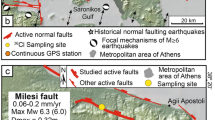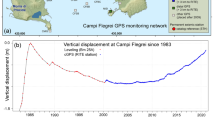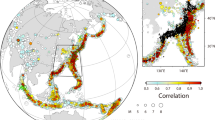Abstract
The independent analyses of GAMA (global positioning system (GPS) array in mid-America) data by Calais et al.1 demonstrate the difficulties in determining patterns of rational deformation within otherwise rigid plates. We are a long way from incorporating this type of information into seismic-hazard analysis, and we agree that longer time spans and improved spatial coverage with geodetic-quality data are required in order to gather the observations necessary to start modelling and understanding this enigmatic region.
Similar content being viewed by others
Main
The uncertainties in the analyses of Calais et al.1 and in our own analysis2 are reported at the 1-sigma level, but are shown at 95% confidence level on the maps (Fig. 2 of ref. 2 mistakenly identifies the uncertainties displayed on the map as 1-sigma rather than as their correct 95% confidence interval). There is no disagreement between the two sets of results1,2 for the far-field component of the array, where uncertainties in both are larger than surface velocities. The differences arise between analyses in the critical near-field sites, which straddle the active faults. Velocity vectors and errors at these sites are remarkably close for the two GAMIT solutions: differences arise from the slightly larger uncertainty in the results of Calais et al..
Unc1ertainties in GPS analyses are poorly understood (see the differences between GIPSY and GAMIT analyses reported in refs 1, 2) and depend on the size of the array being considered and the pattern of deformation being sought. We illustrate this with a simple thought experiment: consider a least-squares fit to a straight line using a set of 150 points with a given error distribution, then add to this a second set of 10 points that span a limited range and for which the slope differs by 10%; it will be almost impossible, by statistical means, to distinguish the second set in the combined set. The statistics of the larger set will dominate the uncertainties of the smaller, and the only way to distinguish the two sets is to limit the data to reveal (perhaps serendipitously) the smaller and significant data set. This effect will be compounded if, in an analysis of a GPS network, the station spacing is larger than the scale expected of local deformation, so that the large-array analysis will probably be aliased.
The illustrated recurrence interval1, based on an assumed upper bound for fault slip of 1.4 mm yr−1, is limited by the assumption that strain accumulation is linear over time (processes of this sort can be nonlinear), and by palaeoseismological evidence indicating an average recurrence (albeit limited by sparse data) of about 500 years (not 600–1,500 years1) over the past 2,000 years2. Such recurrence would, simplistically, require so-called fault-slip rates greater than 4 mm yr−1. However, debating these few data in terms of a specific seismic hazard is risky (and we avoided it earlier2) because the source of such displacements is unknown2: they are snapshots of a potentially complex spatial and temporal pattern of fault-related displacements.
The relationship of our derived displacements and the well known active faults in the New Madrid region remain a compelling argument to us that the system is active, a conclusion borne out by a decade of geological results in the region2. Neither we nor anyone else can so far explain this apparent local deformation — in the spirit of Galileo, “and yet it moves”.
References
Calais, E. et al. Nature 438, doi: 10.1038/nature04428 (2005).
Smalley, R. Jr, Ellis, M. A., Paul, J. & Van Arsdale,R. B. Nature 435, 1088–1090 (2005).
Author information
Authors and Affiliations
Corresponding author
Rights and permissions
About this article
Cite this article
Smalley, R., Ellis, M., Paul, J. et al. Seismology: Tectonic strain in plate interiors? (Reply). Nature 438, E10 (2005). https://doi.org/10.1038/nature04429
Published:
Issue Date:
DOI: https://doi.org/10.1038/nature04429
Comments
By submitting a comment you agree to abide by our Terms and Community Guidelines. If you find something abusive or that does not comply with our terms or guidelines please flag it as inappropriate.



